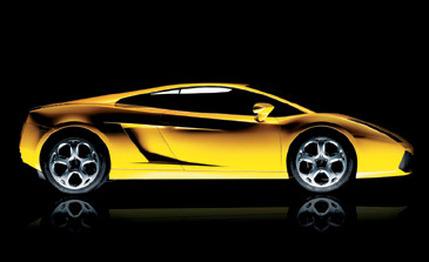 First Drive Review
First Drive Review
This is the sports car Ferrari most fears. With a little help from Audi, its parent company, Lamborghini has finally delivered: The new Gallardo looks like the supercar enthusiasts have dreamed of for years.
The Gallardo-say ga-yar-doh-seems like a miniature Murciélago, but the aluminum V-10-powered sports car is new from the ground up. Insiders swear the mid-engined two-seat coupe is as fast as its big brother V-12 up to 150 mph. For 15 years, since the Lamborghini factory at Sant'Agata last threatened the rule of Ferrari's V-8 (then the 308/328) with the Jalpa, various owners, including Chrysler, have dangled the promise of a baby Lambo in front of the motoring world. Now, finally, under Audi management, Lamborghini can deliver on that tantalizing prospect.
First blood in the revived junior division of the ongoing Ferrari versus Lamborghini supercar battle appears to be going Lambo's way: The Gallardo has 25 percent more horsepower than the 360 Modena (for a total of 493), and at 376 pound-feet, an extra 101 pound-feet of torque. But with a curb weight estimated at 3350 pounds, it carries just 60 to 80 more pounds. The claimed 192-mph top speed is 17 mph ahead of the last 360 Modena we tested, and it should be a sub-4.0-second car to 60 mph (versus the manual 360's 4.4)-significant numbers in the rarefied world of the supercar. There's a price penalty, right? At an estimated base of $160,000, the Gallardo is just small change more than the 360 Modena. And first examples arrive in October.
The styling is pure Lamborghini: gorgeous, if more classic than flamboyant. The single sweeping curve front to rear, first seen on the Countach, dominates its compact, low-slung profile. Orifices abound, of course, and a small spoiler rises out of the tail to improve high-speed stability and reduce lift. So far, Lamborghini makes no claims for aerodynamic drag and downforce, but we know the Gallardo spent many hours in Audi's wind tunnel in Ingolstadt as the designers refined the details and played with underbody airflow. Lamborghini credits Italdesign-Giugiaro for the styling. It's true Fabrizio Giugiaro drew the initial sketches, but the car was then restyled by Luc Donckerwolke, the same designer who penned the Murciélago. Lamborghini says it will build just 1300 Gallardos a year, which probably accounts for the use of a few Audi A4 bits on the console of an otherwise impressively roomy and beautifully finished interior. Of course, it's strictly a two-seater-there's no provision for even tiny rear seats. But the Gallardo is intended to be more livable than its V-12 sibling. This is an everyday supercar, Lamborghini says, to be compared with a Porsche 911 Turbo as much as a 360 Modena, and not a toy for weekend posing. Which may also account for the plan to offer optional 19-inch winter tires as an alternative to the standard 235/35ZR-19 front and 295/30ZR-19 rears.
More Audi influences surface in the car's construction. The aluminum space frame borrows from the knowledge poured into the new A8 and is produced in the same German factory. Aluminum extrusions are welded onto cast corner joints, with aluminum panels welded, screwed, or riveted on top to shape the body. The quality of the space frame is excellent; if anything, it's better than that of its cross-town rival, which uses similar technology. In all the important dimensions, the Gallardo is slightly smaller than the Ferrari but suffers from the same-and seemingly unavoidable-excess of girth, pushing width out to 74.8 inches.